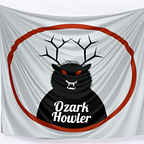Decades of Ozark Howler Censorship Finally Broken
How racism and antiCommunist zeal kept a book from our shelves
It never was in wide distribution, but then, it told stories from a regional culture that has always been marginalized in the United States. As its title suggests, Tales of the Ozark Howler contained folklore from the Ozarks, a remote, hilly, and economically impoverished area in Missouri, Arkansas, and Oklahoma. When people told the story of the glories of America, they never bothered to include this area, but Saul Ashton did for one simple reason: It was his home.
Ashton worked with a set of stories he grew up listening to, about a dark monster that inhabited the shadows of the hills, lurking just out of human sight, releasing its strange howl in the night, “a long strange cry, like the sound of a large, angry pig mixed with the noise of an old steam whistle”. Inspired by the writers of the WPA, Ashton gathered these stories from his neighbors and set them to paper, publishing Tales of the Ozark Howler in 1936.
The author also had experience with another kind of Ozark Mountain: A rigid and racist conservative extremism. This monster ripped him apart from the love of his life because she was African-American, opening a rift between Ashton and his family that grew even wider when he publicly revealed that the Ashton family itself had a grandparent who had been a slave. When he repudiated Christianity and became a Communist, Ashton’s wife and children felt that they had been publicly shamed.
So, after Saul Ashton died unexpectedly in 1938, in order to end what they perceived as their humiliation through their association with his memory, the Ashton memory withdrew Tales of the Ozark Howler from distribution. As Hawthorne Cornus, who organized the re-release of the book this year, explained, “I obtained copyright permission, and more importantly, the personal permission of the Ashton family, to republish Tales of the Ozark Howler only after the death of the author’s final surviving child, Constance. For decades, the Ashton family had held the legal rights to the book only in order to prevent its release, in the hope that it would be forgotten.”
It’s true that the legends of the Ozark Howler have for generations walked boldly along the boundaries that are the most troubling in Southern culture: Borders of religion, race, urban vs. rural, indigenous vs. settler, rich vs. poor, civilization vs. nature. The Ozark Howler breaks the rules that bind us to our humanity.
That’s no reason to keep the stories of the Ozark Howler censored, however. The relevance of these issues, and the terror they place in our hearts, is what makes these stories so evocative. They’re about the things we’re afraid to talk about, but that we desperately need to address.
Saul Ashton’s family ultimately proved unable to censor his work on the folklore of the Ozark Howler. They delayed his impact for decades, but ultimately, curiosity won over fear. We all should heed the moral of the story of Tales of the Ozark Howler. It’s time for us to talk.
